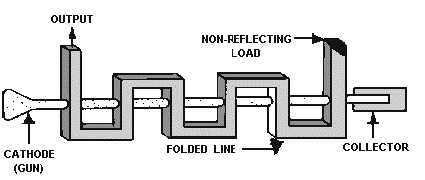2-23
electron gun end of the tube toward the collector is not used in the bwo. Instead, the bwo extracts energy
from the electron. beam by using a backward wave that travels from the collector toward the electron gun
(cathode). Otherwise, the electron bunching action and energy extraction from the electron beam is very
similar to the actions in a twt.
The typical bwo is constructed from a folded transmission line or waveguide that winds back and
forth across the path of the electron beam, as shown in figure 2-16. The folded waveguide in the
illustration serves the same purpose as the helix in a twt. The fixed spacing of the folded waveguide limits
the bandwidth of the bwo. Since the frequency of a given waveguide is constant, the frequency of the bwo
is controlled by the transit time of the electron beam. The transit time is controlled by the collector
potential. Thus, the output frequency can be changed by varying the collector voltage, which is a definite
advantage. As in the twt, the electron beam in the bwo is focused by a magnet placed around the body of
the tube.
Figure 2-16.—Typical bwo.
Q-26. What is the primary use of the twt?
Q-27. The magnet surrounding the body of a twt serves what purpose?
Q-28. How are the input and output directional couplers in a twt connected to the helix?
Q-29. What relationship must exist between the electron beam and the traveling wave for bunching to
occur in the electron beam of a twt?
Q-30. What structure in the twt delays the forward progress of the traveling wave?
The Magnetron
The MAGNETRON, shown in figure 2-17A, is a self-contained microwave oscillator that operates
differently from the linear-beam tubes, such as the twt and the klystron. Figure 2-17B is a simplified
drawing of the magnetron. CROSSED-ELECTRON and MAGNETIC fields are used in the magnetron to
produce the high-power output required in radar and communications equipment.

